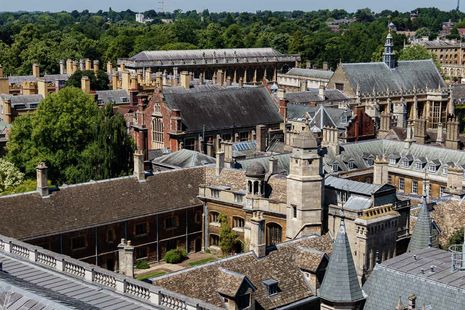Survey of College portrait collections reveals legacy of inequality and colonialism
Women and people of colour continue to be under-represented in college portrait collections, while figures linked to eugenics and colonialism are still memorialised

CN: This article contains detailed discussion of racism, segregation, colonial violence and torture, eugenics, and sexism.
A Varsity investigation into the portrait collections of Cambridge Colleges reveals that individuals with ties to eugenics, racial segregation and colonialism continue to be commemorated. Meanwhile, statistical analysis shows that only 1.87% of individuals depicted are people of colour and only 15.3% are female.
The findings are based on data compiled on over 1700 portraits on ArtUK, as well as information supplied by college archivists. Of the 31 colleges in Cambridge, only Magdalene, Jesus and St Catharine’s did not respond to Varsity’s request for information. King’s declined to offer any statistics on the modern collection and instead provided historic data.
The investigation collected data on the overall race and gender breakdowns of college collections. Overall, only 32 (1.87%) of the figures depicted in the collections surveyed are people of colour.
By way of contrast, the colleges collectively hold 1682 portraits depicting white people. Meanwhile, 50% (14) of the colleges surveyed have no portrait depicting a person of colour in their collection.
Moreover, though four named women of colour are memorialised across the collections at Girton, Clare Hall and Churchill, none of them have any ties to the university. There are, therefore, no portraits of female students, alumnae or fellows of colour in any Cambridge college. This is despite the fact that twentieth-century Cambridge alumnae include — as highlighted by 2018’s ‘Black Cantabs: History Makers’ exhibition at the University Library — the first female Black MP, the first female East African barrister in Britain, and the first Black woman to have a composition performed at the Proms.
According to the data compiled, only 15.3% of figures depicted in portraits were women, a proportion that dropped to 9.22% when portraits from Newnham, Murray Edwards, Lucy Cavendish and Girton - the historically female colleges - were not included.
Both Fitzwilliam and Selwyn display no portraits depicting women, according to their ArtUK pages. They are the only colleges to display no portraits of women or people of colour.
Three colleges, three eugenicists
Among the figures commemorated are Francis Galton, Charles Galton Darwin, and Charles B. Goodhart, memorialised with portraits at Trinity, Darwin and Gonville and Caius respectively.
Francis Galton, who is still memorialised with a portrait at Trinity College, where he studied, was a pioneer of the eugenics movement. He coined the term ‘eugenics’ in 1883 and was involved in controversial studies of twins and of trans-racial adoption, which sought to prove that heredity was fundamental to human development, not upbringing.
Galton’s unpublished novel Kantsaywhere depicted a utopic eugenic religion, designed to build stronger, smarter humans. This June, University College London chose to rename facilities that honoured Galton.
Charles Galton Darwin, whose portrait is displayed in Darwin College, was president of the Eugenics Society from 1953 to 1959. In his 1952 book The Next Million Years, Darwin wrote that a nation should use “A cruder and simpler method [...] than the animal breeder’s” to select “its ablest people” and avoid the “recurrent degeneration” that he argued happened in societies that did not use eugenics. He further argued that eugenics should become a national religion.
At Gonville and Caius, a bust is displayed of Charles B. Goodhart, a mid-twentieth-century member of the Eugenics Society and friend and correspondent of the prominent Caius eugenicist R. A. Fisher.
Fisher was, until recently, honoured with a painting and a stained glass window in the College’s hall. However, both were removed after a lengthy campaign by the JCR’s BME Officer Christine Salami and a petition which amassed almost 1500 signatures.
A Minister of State for the Colonies
Lord Henry Colyton, who is memorialised with a portrait in the Gonville and Caius collection, and gives his name to one of the College’s halls, was Minister of State for the Colonies during the Mau-Mau Uprising in Kenya.
Colyton had direct knowledge of the British government’s use of ‘concentration camps’ and ankle chains against Kenyan civilians, defending the camps in Parliament as “measures to re-educate and humanise the thousands of unfortunate men and women who have been led so wickedly and recklessly down [...] evil paths”.
According to parliamentary records, Colyton further stated on behalf of the government that the camps were “training [the prisoners] so that they would become useful citizens again”, and personally refused to provide food for the children of imprisoned Kikuyu men. The Lord Colyton Hall has hosted college fundraisers and private hire events.
In response to Varsity’s enquiry on Colyton’s memorialisation, a spokesperson for Gonville and Caius commented: “Following the College Council’s decision to remove the Fisher Window from Hall earlier this year, a Working Group on Representation was established with the wide remit of discussing and making recommendations about [...] diversity of representation within College as a whole and within its governance structures. This includes representation in college artwork and commemorations.”
A Prime Minister of the Union of South Africa
Meanwhile, commemorated with a portrait in Christ’s College is Jan Christian Smuts, a former undergraduate and the Prime Minister of the Union of South Africa from 1919 to 1925, and 1939 to 1948.
Smuts frequently voiced support for racial segregation, arguing that South Africa should become “a white man’s land” and avoid “inter-mixture of blood”. He further claimed in 1925 that “if there was to be equal manhood suffrage over the Union, the whites would be swamped by the blacks”. As Prime Minister, he used anthropological arguments to justify racial segregation, and played a major role in South Africa’s move towards legal segregation.
In his first term as Prime Minister, Smuts passed the 1923 Native (Urban Areas) Act, the first law that separated South African cities into Black and white areas, establishing residential segregation, while the Mines and Work Act, written by Smuts as Mines Minister in 1911, brought into law the principle of skilled jobs being reserved for white people.
A page on the Christ’s website describes his ‘important role at the Paris Peace Conference in 1919’, but makes no mention of his role in establishing racial segregation.
In a joint statement to Varsity, Howard Chae and Chloe Newbold, the SU BME officer and Women’s officer respectively, commented: “College portraits commemorate key benefactors and figures, symbolising the college’s ethos, values, and history.”
They continued: “The continued commemoration of individuals such as Smuts in Christ’s and Rustat in Jesus, among others, are an example of this. Colleges need to commit to concrete actions to materially address these ties and create a more welcoming environment for marginalised students by, for example, adopting the recommendations of the End Everyday Racism report, implementing programmes of reparative justice to follow Legacies of Enslavement enquiries, and ending their ongoing complicity in the global injustices carried out by fossil fuel corporations and arms manufacturers.”
Jesus, Emmanuel, Trinity, Selwyn, Fitzwilliam and Darwin did not respond to Varsity’s request for comment.
Note about statistics: the statistics used have been compiled on the basis of ArtUK collections, for every college except Churchill, Downing, Lucy Cavendish and King’s, for which the statistics are based on information provided by college archivists.
 Features / How sweet is the en-suite deal?13 January 2026
Features / How sweet is the en-suite deal?13 January 2026 Comment / Will the town and gown divide ever truly be resolved?12 January 2026
Comment / Will the town and gown divide ever truly be resolved?12 January 2026 News / 20 vet organisations sign letter backing Cam vet course13 January 2026
News / 20 vet organisations sign letter backing Cam vet course13 January 2026 Arts / Fact-checking R.F. Kuang’s Katabasis13 January 2026
Arts / Fact-checking R.F. Kuang’s Katabasis13 January 2026 Music / Inside Radiohead’s circle13 January 2026
Music / Inside Radiohead’s circle13 January 2026










